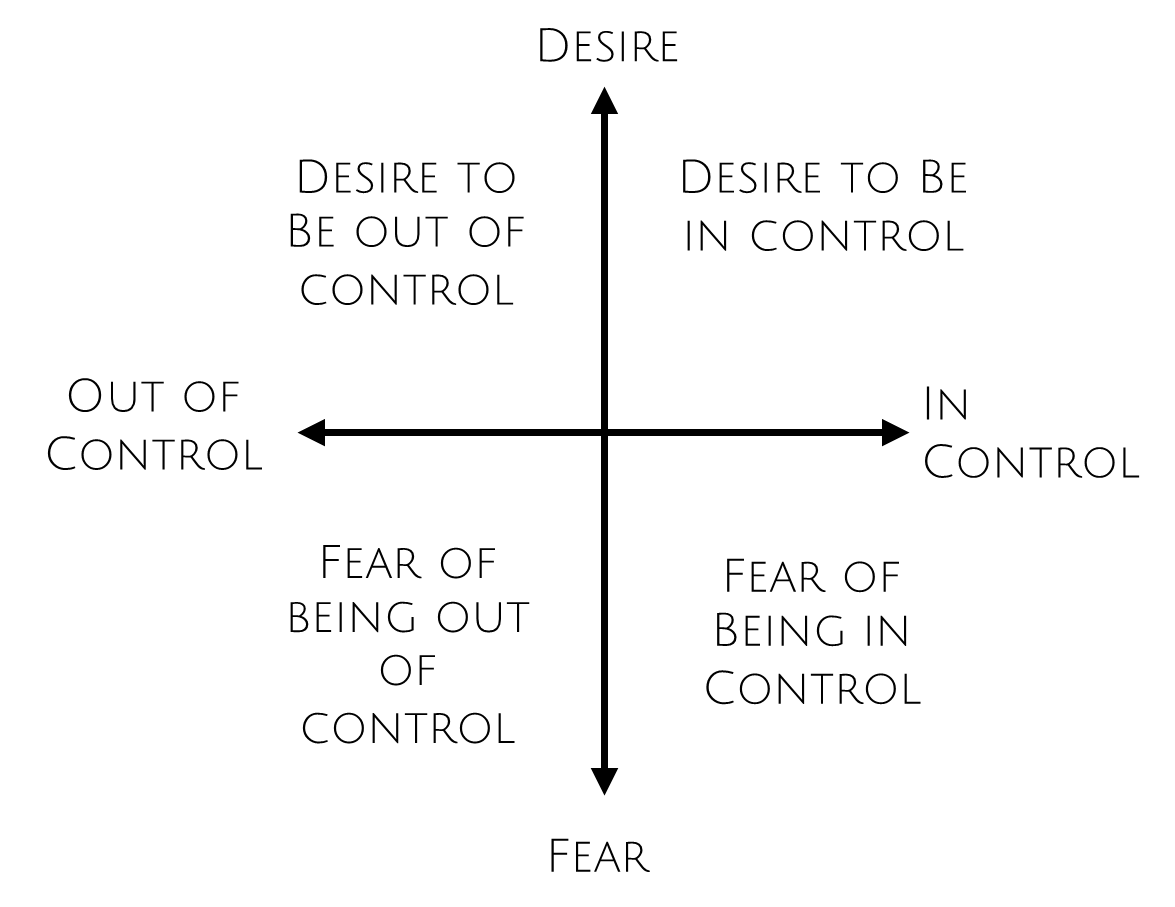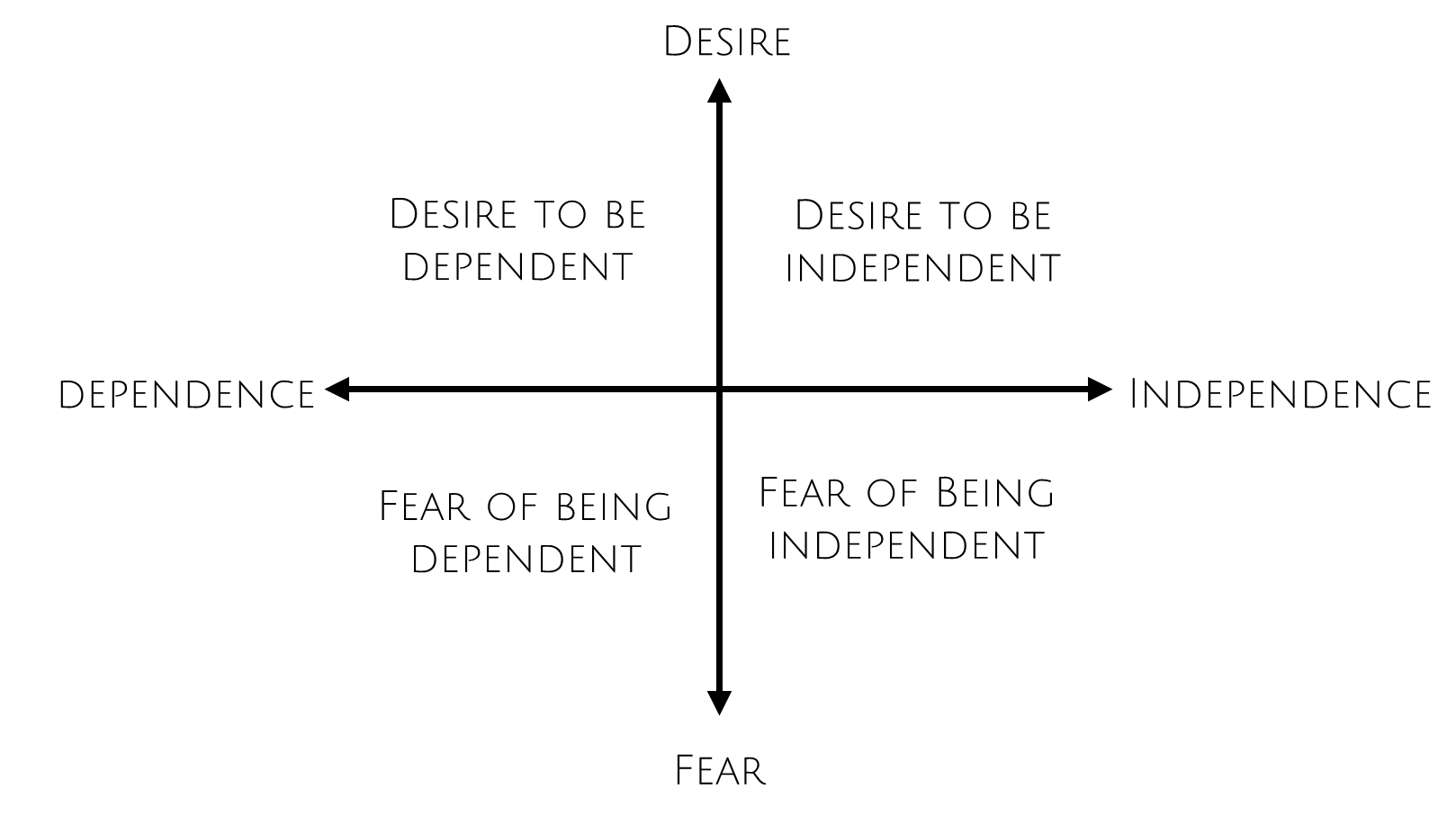Last week I discussed our tendency to get attached to a single point of view, and how this often keeps us stuck. When we recognize the validity of other perspectives – and allow that both sides are within us (and also in our adversaries, be they real or imaginary) – this helps to neutralize the issue. For a deeper and more thorough exploration, we can look at the two sides of an issue intersected with the push and pull of desire and fear (or attraction and repulsion). It’s a process Leslie Temple Thurston simply calls “squares.”
Here are some examples. If you find them challenging, I encourage you to work through them. If not, I hope they help you understand how the exercise works and lead you to the patterns that are relevant to you.

In this first example, we’re looking at the intersection of desire and fear with that of being in control versus out of control. Wanting control is a primary human motivator. A great many of our upsets can be traced to an underlying fear of being out of control. But pursuing control may amplify the belief that we’re not in control. This can be a tricky catch-22 to work with. So if you have a strong desire to be in control (upper right quadrant), you’d do well to address yourself to the fear of being out of control (lower left). These are easy for most people to access.
Can you think of a situation that arouses the fear of being out of control? Holding that in mind, what happens in your body? Can you feel some physical unease? What happens if you don’t resist that feeling? What happens if you even invite it to be felt with your whole being, willingly allowing it spread over you? And what happens when you imagine opening yourself, like opening a closed fist that contains a butterfly, and let it peacefully depart? If this process diminished the intensity of the feeling, but not completely, try doing it several times in succession. For more on this form of body-centered releasing, check out our book, Freedom.
Less obvious – but not uncommon – is the fear of being in control (lower right quadrant). If you’re in control, does that mean whatever happens is your fault? Maybe being in control feels like too much responsibility. If control issues are significant for you, I encourage you to do the process described in the last paragraph with the idea of situation in which you are in control. What comes up?
Last, there’s the desire to be out of control (lower left quadrant). Though this may seem totally foreign to someone who’s rigidly clenching around every aspect of life, there’s always a hidden part that yearns for the relief of being out of control. Anyone who’s ever been to a college party at the end of finals has witnessed plenty of desire to be out of control.
Try visiting with all four quadrants and journaling about how each state exists in you. You might also have fun with the following variation – desire and fear of independence versus dependence.

This is a major dynamic in kids and adolescents, and it’s not helped by the fact that parents often give mixed messages. On the one hand, we may be telling our kids to stay attached to the family, don’t try to get your needs met by your inept peers, and keep coming to us for support and advice. On the other, we’re telling them to grow up, do more things for themselves, get themselves ready for school, figure out their homework, and navigate new situations with minimal guidance. When we see them shifting their attachment from the family to their peers, we often mistake this for independence, when they’ve actually become dependent on peers for approval and direction.
It’s probably easy for them to access the desire to be independent, even if it’s scary, because our society puts so much value on it. If we can help them recognize the other three quadrants, it may help to neutralize some of the inner and outer forces, and allow them to be accepting of where they are and comfortable with striking a balance.
Of course these dynamics don’t necessarily end when adolescence does. We may find ourselves struggling with the dimensions of dependence and independence in our adult relationships, and when handicapped, ill, or elderly. Exploration and peacemaking with these states may support a peaceful resolution.
Be well,
Peter
P.S. If you find this exploration interesting, perhaps you’d enjoy guiding others through processes like these. Check out the Dragontree Coaching Program. In the advanced Illuminator training, we go even deeper into these processes.



 Cart
Cart
